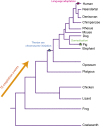Comparative genomics as a tool to understand evolution and disease
- PMID: 23817047
- PMCID: PMC3698499
- DOI: 10.1101/gr.157503.113
Comparative genomics as a tool to understand evolution and disease
Abstract
When the human genome project started, the major challenge was how to sequence a 3 billion letter code in an organized and cost-effective manner. When completed, the project had laid the foundation for a huge variety of biomedical fields through the production of a complete human genome sequence, but also had driven the development of laboratory and analytical methods that could produce large amounts of sequencing data cheaply. These technological developments made possible the sequencing of many more vertebrate genomes, which have been necessary for the interpretation of the human genome. They have also enabled large-scale studies of vertebrate genome evolution, as well as comparative and human medicine. In this review, we give examples of evolutionary analysis using a wide variety of time frames-from the comparison of populations within a species to the comparison of species separated by at least 300 million years. Furthermore, we anticipate discoveries related to evolutionary mechanisms, adaptation, and disease to quickly accelerate in the coming years.
Figures



References
-
- Aitken RJ, Marshall Graves JA 2002. The future of sex. Nature 415: 963. - PubMed
-
- Bejerano G, Pheasant M, Makunin I, Stephen S, Kent WJ, Mattick JS, Haussler D 2004. Ultraconserved elements in the human genome. Science 304: 1321–1325 - PubMed
-
- Bejerano G, Lowe CB, Ahituv N, King B, Siepel A, Salama SR, Rubin EM, Kent WJ, Haussler D 2006. A distal enhancer and an ultraconserved exon are derived from a novel retroposon. Nature 441: 87–90 - PubMed
Publication types
MeSH terms
LinkOut - more resources
Full Text Sources
Other Literature Sources
